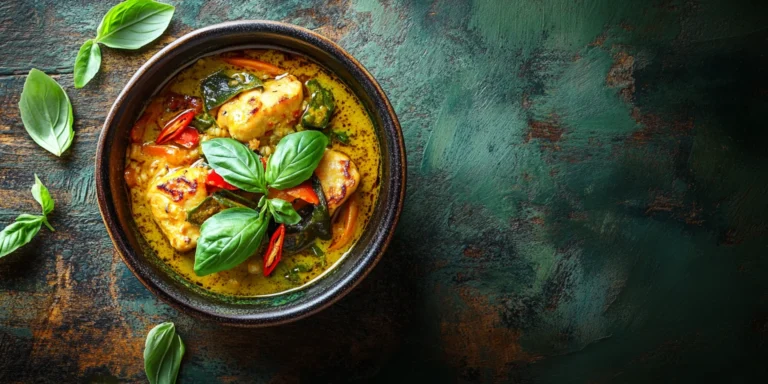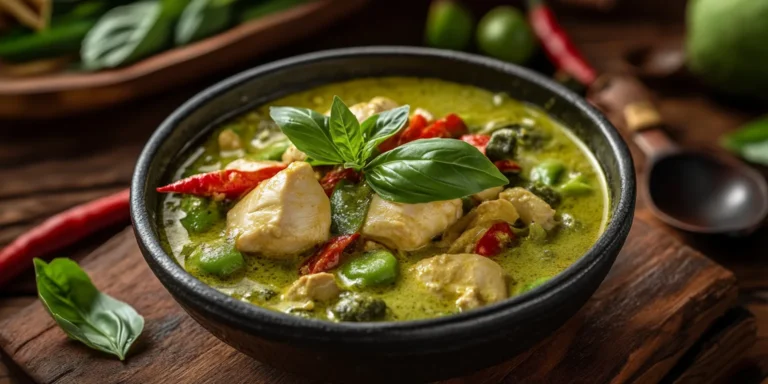How did a dish born between the reigns of two Thai kings capture the hearts of food enthusiasts worldwide? Dive into the rich history and vibrant taste of one of Thailand’s spiciest yet most beloved dishes: Thai Green Curry.
Whether it’s the best Thai Green Curry you’ve been yearning to taste or the journey to crafting an authentic Thai Green Curry at home, this aromatic delight offers more than just a meal—it provides an immersive cultural experience. With convenient online options, bringing the best Thai Green Curry from the bustling streets of Thailand to your doorstep has never been easier.
Key Takeaways
- The evolution of Thai Green Curry from 1908 to 1926 during the reigns of King Rama VI and VII.
- Insights into the spicy allure of Thai Green Curry and how it ranks among Thai curries.
- The soothing role of coconut cream and how it transforms the dish’s texture and taste.
- Chicken as the classic protein that harmonizes with the curry’s flavors.
- Recommended sides that best complement Thai Green Curry, highlighting jasmine rice and vermicelli noodles.
- Tips on using premade Thai Green Curry paste such as Valcom for both traditional and modern culinary creations.
Introduction to Thai Green Curry
Thai Green Curry is known for its bright color and bold flavors. It’s a key dish in Thai cuisine. Made with Thai Green Curry Ingredients like green chilies and lemongrass, it’s aromatic and fresh. Homemade Thai Green Curry brings Thailand’s essence to your kitchen.
Thai Green Curry started in the early 20th century. It became popular under King Rama VI and Rama VII. This curry mixes Thailand’s history and culinary innovation. Every bite of Thai Green Curry Recipe tells a story of the nation.
Thai Green Curry Recipe uses a paste of fresh ingredients. This highlights the importance of using local and fresh items in Thai cooking. It’s more than just food; it’s a way to experience Thai tradition.
| Curry Type | Key Ingredients | Flavor Profile |
|---|---|---|
| Green Curry | Green chilies, lemongrass, cilantro roots | Piquant, Aromatic |
| Red Curry | Up to 20 red chilies, galangal | Spicy, Deep |
| Yellow Curry | Turmeric, curry powder, coriander seeds | Mild, Sweet |
| Massaman Curry | Whole spices, peanuts | Mild, Slightly Sweet |
| Penang Curry | Dried or fresh red chilies | Rich, Sweet, Dry |
| Sour Curry | Fish or pork, minimal spices | Distinct, Sour |
Whether you’re making Homemade Thai Green Curry or trying other Thai curries, there’s a lot to explore. Each curry has its own flavors and ingredients. From Massaman’s sweetness to Red curry’s spiciness, Thai cuisine has something for everyone.
The Cultural Significance of Authentic Thai Green Curry
The rich tapestry of Thai culture is beautifully embodied in the flavors and history of Authentic Thai Green Curry. This dish is not just a staple on the dining table. It is a vibrant symbol of Thailand’s culinary expertise. It also shows the country’s historical evolution, influenced heavily by its gastronomical practices.

Understanding the depth of Authentic Thai Green Curry begins with recognizing its cultural footprint. It is tied closely to Thailand’s major historical and culinary milestones. The creation and popularization of this dish encapsulate an era of significant transformation within the region. This includes political shifts to global recognition.
| Year | Event | Significance |
|---|---|---|
| 1926 | First known mention of Thai green curry | Documented in a cookbook by L Phaehtraarat, marking its culinary documentation in Thai culture. |
| 1967 | First Thai restaurant in UK | Introduces Thai green curry to a Western audience, broadening its cultural impact. |
| 2001 | Opening of Nahm in London | First Thai restaurant to win a Michelin star, elevating the global prestige of Thai cuisine. |
| 2006 | Launch of Thai Select scheme | Endorses authentic Thai restaurants globally, enhancing the recognition of Thai green curry. |
| 2017 | Michelin Guide arrives in Bangkok | Further puts Thai green curry on the global gastronomic map, affirming its status in world cuisine. |
The evolution of Authentic Thai Green Curry is not just a narrative of flavor. It is also of cultural identity and international diplomacy. The Thai government’s gastropolitical strategies, including the Global Thai Program, significantly propelled the popularity of this exquisite dish. Authentic Thai Green Curry has thus transcended borders, bringing a taste of Thai heritage to global palettes.
The inclusion of Authentic Thai Green Curry in military ration packs and notable culinary literature further showcases its integral role. It symbolizes a bridge between traditional Thai flavors and modern culinary practices. This dish’s journey from a regional specialty to a beloved global phenomenon underscores its profound cultural significance.
Crafting the Perfect Thai Green Curry: A Step-by-Step Guide
Starting an Easy Thai Green Curry is all about knowing the steps and picking the right ingredients. This guide will show you how to make a homemade Thai green curry. It’s easy to follow and will make a delicious meal for everyone.
First, we’ll make the Thai Green Curry Paste. This paste is key to your curry’s taste. It’s made from green chilies, shallots, garlic, and more. These ingredients are ground into a paste that gives your curry its flavor.
Now, let’s talk about cooking the curry. Start by heating the paste in a pan until it smells great. Then, add coconut milk slowly. This makes the curry creamy. Next, add vegetables and protein like tofu or chicken. Cook them until they’re just right.

Fresh veggies are important in your curry. For a big batch that serves six, use six cups of different veggies. Mushrooms, broccoli, and snow peas are great choices. They add flavor and texture to your curry.
| Ingredient | Quantity | Preparation |
|---|---|---|
| Button Mushrooms | 8 oz. | Blanched for 3 mins |
| Snow Peas | 1 cup | Blanched for 1.5 mins |
| Chopped Broccoli | 2 cups | Blanched for 3 mins |
| Extra-Firm Tofu | 8 oz. | Diced & Stirred into curry |
| Light Coconut Milk | 1.5 cups | Mixed with green curry paste |
| Green Curry Paste | 1/4 cup | Sautéed before adding milk |
| Vegetable Broth | 2 cups | Added to curry base |
| Soy sauce | 1 tsp | Mixed into curry base |
| Sugar | 1 Tbsp | Enhances flavor |
By following these steps and using the right ingredients, you can make a delicious Easy Thai Green Curry. It’s perfect for any meal and tastes amazing.
Variations of Thai Green Curry: From Classic to Modern Twists
The many Thai Green Curry Variations show a rich culinary tradition. It’s always evolving to meet new tastes and dietary needs. The traditional paste includes lemongrass, galangal, and shrimp paste. But now, Modern Thai Green Curry has Vegetarian Thai Green Curry options too. These use soy sauce instead of shrimp paste for vegans and vegetarians.
Exploring Thai green curry means understanding these changes in the context of Thai food. For more on Thai curry, check out a guide here. It dives into the flavors and ingredients that make each curry unique.
Making curry paste traditionally uses a mortar and pestle. But today, many use blenders for ease. Both methods ensure the curry is full of flavor and aroma.
- Traditional Thai Green Curry – Uses homemade green curry paste and ingredients like Thai eggplants and chicken.
- Vegetarian Thai Green Curry – Uses tofu and lots of vegetables with vegan curry paste.
- Modern Thai Green Curry – Adds ingredients like avocado or quinoa, as seen in this Vegan Thai Green Curry with Tofu.
Thai Green Curry is versatile and can be paired with many proteins and vegetables. It’s loved in Thai restaurants and homes around the world. Whether you like the spicy classic or a milder vegetarian version, Thai green curry is a canvas for creativity.
Conclusion
Exploring the Perfect Blend of Spices, Thai Green Curry is a journey into Thai food culture. It’s a dish that shows off Authentic Thai Flavors, loved by both chefs and home cooks. With a whole chicken and 150 grams of Thai green chilies, each ingredient adds to the dish’s unique taste.
The process of pounding the curry paste for 1.5 hours and adding coconut cream carefully shows a commitment to tradition. This method ensures the curry’s texture and sweetness, without using sugar.
Thai Green Curry has a long history, starting in central Thailand during King Rama VI’s time. It has become a key part of international cuisine, showing Thailand’s rich culture and history. Cooking it involves boiling chicken, simmering vegetables, and finishing with fresh Thai herbs.
This curry is versatile, working well with chicken, beef, tofu, or shrimp. Served with jasmine rice or Basmati, it becomes a complete meal. Thai Green Curry is a dish that celebrates Thai cooking traditions, offering a flavorful experience.
FAQ
What are the key ingredients in an authentic Thai green curry?
An authentic Thai green curry includes green curry paste, coconut milk, and bamboo shoots. It also has chicken or tofu for vegetarians. Thai basil, fish sauce or soy sauce, and vegetables like eggplant and bell peppers are key. Fresh herbs like cilantro, lime leaves, and lemongrass add depth to the flavor.
Can I make Thai green curry paste at home?
Yes, you can! To make homemade Thai green curry paste, blend green chilies, shallots, garlic, and galangal. Add lemongrass, cilantro roots, cumin, coriander seeds, white peppercorns, shrimp paste or miso paste, and lime zest. This will give you that vibrant, authentic flavor.
How do I cook authentic Thai green curry?
Start by sautéing the green curry paste in a little oil. Then, add your protein and vegetables, coating them well with the paste. Pour in coconut milk and bring to a gentle simmer.
Season with fish sauce or soy sauce and palm sugar. Add kaffir lime leaves and Thai basil for extra aroma. Simmer until the ingredients are cooked through and the curry is slightly reduced.
Is Thai green curry spicy?
Thai green curry is known for being spicy because of the green chilies. But, you can adjust the spiciness by using fewer chilies. The coconut milk also helps to mellow the heat, making the curry rich and creamy.
Can I make Thai green curry ahead of time?
Yes, you can make Thai green curry ahead of time. It often tastes better the next day, as the flavors meld together. Store it in the fridge and reheat gently before serving. Add fresh herbs like Thai basil before serving to keep them vibrant.
What’s the best way to serve Thai green curry?
Serve Thai green curry with steamed jasmine rice or rice noodles. This helps soak up the rich curry sauce. Garnish with fresh cilantro, additional red chilies, or a squeeze of lime juice for extra flavor and presentation.
Are there vegetarian options for Thai green curry?
Yes, there are! Vegetarian Thai green curry is delicious and can be made with tofu, tempeh, or vegetables. Use soy sauce or vegan fish sauce to keep it vegetarian-friendly.
How can I achieve the best flavor in my homemade Thai green curry?
For the best flavor, use fresh ingredients, including herbs and spices. Making your own green curry paste also improves the taste. Slowly simmering the curry allows the flavors to meld beautifully.

Leave a Reply